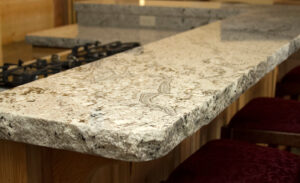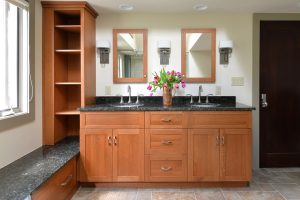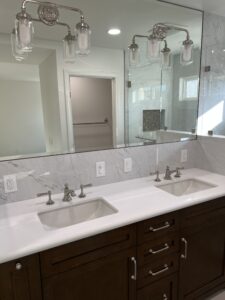Countertop Edging
Selecting countertop edging, also referred to as edge treatments, is an important part of your bathroom or kitchen remodeling project. The edge profile is a defining feature of the room. Deciding on the countertop edging that is right for you requires some basic knowledge of material types and what’s available.
What type of Material Should I Choose when Selecting my Countertop Edging?
Virtually all remodels use Granite or Quartz for their countertops. Therefore, this discussion will focus on these two materials for countertop edging. Regarding which material is best for you, read what is better granite or quartz for your kitchen and bathroom remodel.
There are different thicknesses in countertop material. Most folks are unaware of this fact. It is extremely important than when hiring a Contractor to remodel your kitchen or bathroom, you ask how thick the material will be. Thickness has a substantial impact on durability, performance, and your options when selecting countertop edging.
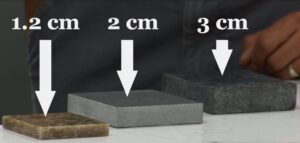 | 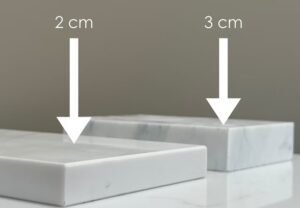 |
Never use anything less than 2 cm for your countertops. Anything less than 2 CM is too weak and will crack, chip, and break. Countertop thickness typically ranges from 3/4 inch (2 cm or 20 mm) to 1-1/4 inches (3 cm or 30 mm). The best and most popular size is 3/4 inch (2 cm). Why? It’s very strong, durable, priced better, and much lighter than 3 cm. The strength and aesthetic appeal of 2 cm is hard to beat, especially in high traffic kitchen and bathroom areas.
Weight is very important. A 3 cm granite slab will weigh about 2,376 pounds (22 pounds per square foot) while a 2 cm will weigh around 1,296 pounds. A quartz slab on the other hand, typically only weighs about 715 pounds (13 pounds per square foot). This weight difference is significant when sitting on top of your cabinets, especially over time! I can’t stress how important it is how your cabinets are made and installed when it comes to countertop weight.
When Deciding on a Countertop, is Granite or Quartz Better?
I have written a very informative article on this very topic. It’s titled “What is better granite or quartz for your kitchen and bathroom remodel?” In summary, quartz is superior to granite. Quartz is nearly indestructible! It’s significantly harder than granite and is not porous. Because it’s not porous, it’s impervious to bacteria, mold, mildew, and E.coli. It never needs to be sealed, has the look of stone, extremely durable, and is the most diverse when it comes to countertop edge design. Quartz can handle the most intricate edge profiles.
Are there Limitations on What Type of Countertop Edging I can Pick?
Yes. Countertops can be laminated or chiseled. Some people refer to non-laminated countertops as solid surface. This would be incorrect as any man-made countertop is considered solid surface. Solid surface does not define the countertop edge detail. Using the term “Chiseled” makes clear we are talking about a countertop without laminated edging.
Each will only accommodate certain countertop edging. Chiseled does not have a glued edge detail while laminated does. There are more options with laminated than chiseled countertop edging. A laminated edge is created by adhering two pieces of quartz or granite together, effectively doubling the thickness of the countertop edge. A chiseled edge has a series of sharp, angled, jagged cuts or the edge is fabricated without adhering to a second piece of edge material. Chiseled edged countertops sit flush on the top of the cabinets, they do not wrap down around the face of the cabinet like a laminated countertop.
|
|
|  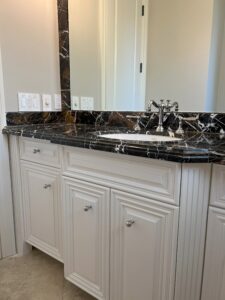
|
Are There Common Countertop Edge Styles?
Yes. There are 4 basic countertop edge categories as follows: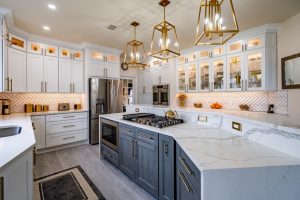
- Straight Edge: This is a clean, simple, and versatile option with a slightly rounded corner.
- Eased Edge: A subtle variation of the straight edge, featuring a slightly rounded corner for a softer look.
- Beveled Edge: Features a subtle angle cut along the top edge, creating a more elegant look.
- Rounded Edge: A simple, smooth, and rounded edge, offering a soft and comfortable feel.
What About More Elaborate Countertop Edge Styles?
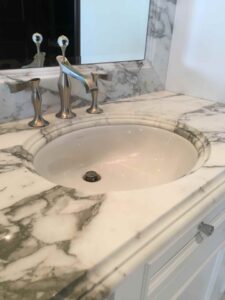 Ogee and custom edge treatments are the most sophisticated and come with higher fabrication costs. These include:
Ogee and custom edge treatments are the most sophisticated and come with higher fabrication costs. These include:
- Mitered Edge: A clean, seamless edge where the countertop pieces are joined at a 45-degree angle.
- Dupont Edge: Features a squared edge with a small, rounded corner.
- Waterfall Edge: A design where the countertop material extends down the sides, creating a seamless look.
- Cove Edge: A concave curve that adds a decorative touch to the countertop edge.
- Double or Triple Edges: Combinations of different edge styles, such as double beveled or double ogee, for a more luxurious look.
When Selecting my Countertop Edge Style, What Should I Consider?
When selecting a countertop edge, it’s important to keep these items in mind:
- Aesthetics – Choose an edge style that complements your overall kitchen or bathroom design.
- Functionality – Consider how the edge will be used and whether a rounded or eased edge is more practical for safety.
- Budget – Some edge styles, particularly more elaborate ones, may come at a higher cost.
What Countertop Edging Can I use for Chiseled and Laminated Granite and Quartz?
Not all edge treatments can be used on chiseled profiles. Since chiseled sits flush and has no laminated (glued) edge, the more intricate edging profiles cannot be used. Laminated countertop edging has more options.
Certain countertop materials may not be able to accommodate all edge styles. Quartz countertop edge profiles are usually the most diverse, since quartz is durable and can handle even the most intricate edge designs.
If you have a large, spacious kitchen, most countertop edges will look great. However, if you have a smaller kitchen, or a kitchen with tight corners, you may want to choose a subtle edge profile. You should be able to move around counter corners without bumping into them. Ornate countertop edges such as ogee edges fit in with traditional style kitchens, while simpler edges like square or beveled edges better suit contemporary kitchens. The more detailed your countertop edge, the more it costs.
For bathrooms, a softer, more round edge is better. More rounded edge treatments like Bullnose, Radius, and Eased are much safer for bathrooms and more comfortable. A rounded edge is easier to grasp. It is also superior for safety should you slip and fall (most accidents in the home occur in the bathroom). As for comfort, most folks are lightly dressed when they perform their morning hygiene routine in the bathroom. Leaning against a sharp edge to apply makeup, shave, brush your teeth, and wash can be uncomfortable and pinch your skin.
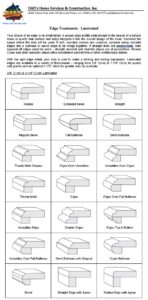
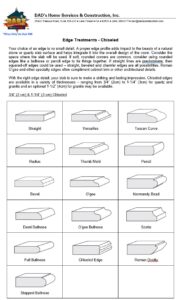
Always Hire a Reliable and Dependable Contractor to Remodel your Bathroom and Kitchen
 Always work with a trustworthy contractor like DAD’s Construction. We are experts in bathroom remodeling and kitchen remodeling. We manage projects in an efficient manner. DAD’s Construction will do everything to minimize the possibility of change orders. Our team will make sure we have all the necessary information to prepare a proposal that meets your requirements. Rest assured that we will provide you with a detailed, by line-item contract. We will make sure that the contents of this agreement are properly and clearly communicated to you. If you have questions or need updates regarding your project, we will always answer your inquiries.
Always work with a trustworthy contractor like DAD’s Construction. We are experts in bathroom remodeling and kitchen remodeling. We manage projects in an efficient manner. DAD’s Construction will do everything to minimize the possibility of change orders. Our team will make sure we have all the necessary information to prepare a proposal that meets your requirements. Rest assured that we will provide you with a detailed, by line-item contract. We will make sure that the contents of this agreement are properly and clearly communicated to you. If you have questions or need updates regarding your project, we will always answer your inquiries.
How Can I Receive More Information on Remodeling my Bathroom and Kitchen?
If you would like more information on enjoying the best bathroom, kitchen, and interior remodeling experience in Orange County, call Dan at (949) 380-0177 or at dan@dadsconstruction.com for a free in home consultation. DAD’s serves all of South Orange County California. This includes Lake Forest, Mission Viejo, Rancho Mission Viejo, Foothill Ranch, Portola Hills, Ladera Ranch, Irvine, San Clemente, Dana Point, San Juan Capistrano, Rancho Santa Margarita, Coto de Caza, Dove Canyon, Laguna Niguel, Laguna Hills, Laguna Beach, Newport Beach, Orange, and Aliso Viejo.

